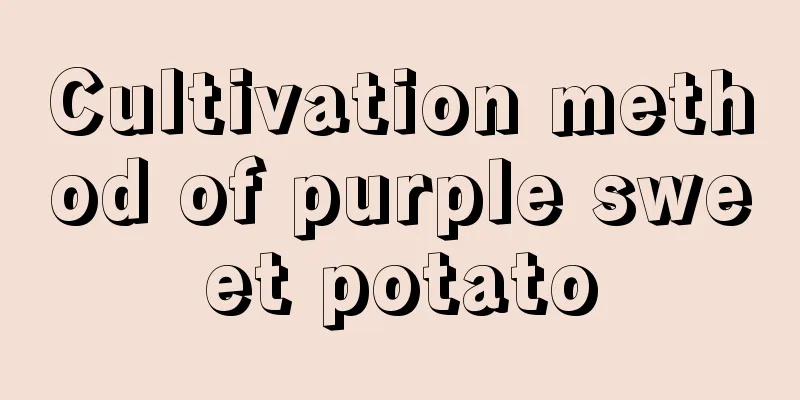Cultivation method of purple sweet potato

|
Purple sweet potato is a food ingredient with high nutritional and medicinal value. Its skin is purple and its flesh is soft and sweet. It is not only edible, but can also be processed into various delicacies. Nowadays, the market prospects for purple sweet potatoes are broad. Let’s talk about the cultivation methods of purple sweet potatoes. 1. Variety selection Purple sweet potatoes can be divided into raw edible type and processed type according to their uses. For raw edible type, choose varieties with good taste, moderate pigment content, good disease resistance, and beautiful sweet potato shape. For processed type, choose varieties with high pigment, good disease resistance, and high dry rate. 2. Seedling selection When the temperature reaches about 15 degrees in mid-February, purple sweet potatoes can be taken out of the cellar for seedling cultivation. A seedbed should be made, and the seeds should be laid horizontally on the seedbed. They should be covered with fine soil and film. When the seedlings grow to more than 20 cm, they can be planted in the field. 3. Apply enough basal fertilizer Purple sweet potato cultivation should apply sufficient basal fertilizer. Generally, 40 to 50 dan of high-quality organic fertilizer and 35 to 50 kg of nitrogen, phosphorus, potassium and compound fertilizer are applied per mu. Organic fertilizer is applied before tillage, and compound fertilizer is used as core fertilizer when monopolized. 4. Cultivation management After the purple sweet potato is made into ridges, apply herbicide once while the soil is moist to prevent weed growth, and till the soil 2 to 3 times, combining inter-cultivation with soil monopoly. Be afraid of sewage, and take timely anti-drought measures when drought is severe. 5. Raise the vines at the right time Purple sweet potato vines have vigorous growth and many roots during the festivals. Lifting the vines is the key to increasing sweet potato yields. Do not disrupt the direction, but do not raise the vines. Raising the vines disrupts nutrient transport, generally reducing production by 30%. 6. Pest and disease control (1) Black spot disease Symptoms: Lesions often occur on wounds and are black to brown, round or irregular in shape, with a slight depression in the center. Prevention and control: Soak in 1000 times diluted 50% carbendazim wettable powder for 10 minutes, or soak in 50% carbendazim for 500-700 minutes. (2) Soft rot Symptoms: Purple sweet potatoes are soft and rotten, with a lot of water, which farmers call "water-rotten". The potato flesh is light yellowish white and has a fragrant smell. Prevention and control: Soak the potato tubers 1 to 2 times with 500 to 70% methyl thiophanate wettable powder diluted 500 to 700 times, the effect is good. (3) Root rot Symptoms: The roots become infected and form dark brown spots, the leaves become infected and wither, and the tubers become infected and form deformed tubers. Prevention and control: Spray twice with 700~1000 times diluted 50% thiophanate-methyl wettable powder, the effect is good. (4) Small elephant beetle Harm: Adult insects bite young shoots, stems, petiole cortex, and roots, seriously affecting yield. Prevention and control: In the early stage, you can use Farmland Water to sprinkle potato heads, or spray them with a mixture of 600 times dichlorodiphenyltrichloroethane and Kung Fu. 7. Harvest and storage Purple sweet potatoes require harvesting in mid-to-late October, while fresh edible sweet potatoes can be delayed until early November. They must be harvested before frost. Ventilation and humidity reduction are required in the early stage of storage, and heat preservation and moisture retention are required in the later stage. That’s it |
<<: Common diseases and prevention methods of centipede breeding
>>: Symptoms and control measures of watermelon virus disease
Recommend
What is the difference between red diamonds and gold diamonds?
1. Different varieties Red diamonds are one of th...
How to propagate Nepenthes and what to pay attention to
Nepenthes reproduction method Common propagation ...
How to fertilize marigolds
How to grow marigolds Marigolds are usually sown ...
Eight taboos for hamster breeding
Hamsters are a general term for animals of the ha...
Which one is better at removing formaldehyde: Chlorophytum or Pothos
1. Which effect is stronger? Both spider plants a...
Pests and diseases of white flower and their control methods
Common diseases of white flower tenacity: anthrac...
How to deal with ranunculus after flowering
1. Flowering period Generally speaking, it blooms...
What to do if the green radish grows too tall
What does the green radish look like when it grow...
Time and method of planting sweet potatoes in the north
Sweet potato planting time in the north Sweet pot...
To improve your wealth, career and luck, plants can help!
1. Place plants in the living room to bring joy t...
The cost and profit of planting dragon fruit per acre
The cost of growing pitaya is relatively high in ...
How to grow lavender
1. Breeding environment 1. Soil: Lavender prefers...
How to grow a potted golden jujube tree? How to grow a golden jujube bonsai
Potted cultivation method of golden jujube tree 1...
When is Wuchang rice harvested?
Wuchang rice is a specialty rice of China. It is ...
How to make the Staghorn Begonia bloom
environment Staghorn begonia prefers a dry climat...









